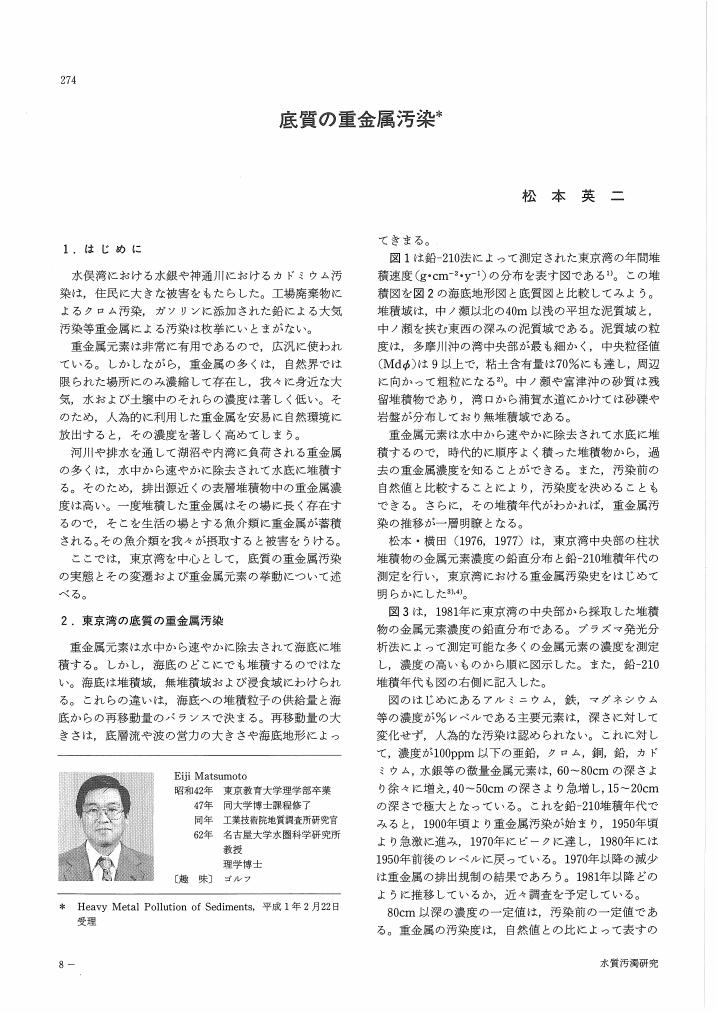3 0 0 0 OA ハイドロアイソスタシーと西九州の水中遺跡
- 著者
- 中田 正夫 前田 保夫 長岡 信治 横山 祐典 奥野 淳一 松本 英二 松島 義章 佐藤 裕司 松田 功 三瓶 良和
- 出版者
- Japan Association for Quaternary Research
- 雑誌
- 第四紀研究 (ISSN:04182642)
- 巻号頁・発行日
- vol.33, no.5, pp.361-368, 1994-12-31 (Released:2009-08-21)
- 参考文献数
- 12
- 被引用文献数
- 13 14
西九州には縄文早期の鷹島遺跡や数多くの縄文前期から中期の水中遺跡が存在する. これらの遺跡が水没したおもな原因は, 最終氷期の大陸氷床の融解に伴うハイドロアイソスタシーに帰すことができる. 本論文では, このことを定量的に示した. この研究をさらに進めることは, 両極の氷床モデルや地殻とマントルのレオロジーを推定するのに非常に有益である.
2 0 0 0 OA 大阪湾底泥の堆積速度と重金属汚染
- 著者
- 松本 英二 横田 節哉
- 出版者
- 日本海洋学会
- 雑誌
- 日本海洋学会誌 (ISSN:00298131)
- 巻号頁・発行日
- vol.34, no.3, pp.108-115, 1978-06-30 (Released:2011-06-17)
- 参考文献数
- 12
- 被引用文献数
- 20
The accumulation rates of sediment cores in Osaka Bay have been determined by using 210Pb dating technique. In the upper 10 cm 210Pbex contents show a constant value with depth. The accumulation rates below the homogeneous layer of sediments ranging from 0.12 to 0.61 cm y-1 (0.067-0.34 gcm-2y-1) were obtained. The higher contents of Zn, Cu, Pb and Cr were observed in the upper 10 to 30 cm of sediments. Assuming that the increment of heavy metal content in sediments is due to anthropogenic origin, the amount of anthropogenic input of heavy metals into sediments were estimated to be 1, 300-2, 700μg cm-2 for Zn, 150-480 for Cu, 360-410 for Pb and 320-480 for Cr. The increment appears to start about 100 years ago. In surfical sediments most of heavy metal contents exceeded the background content, and thenmost part of Osaka Bay is polluted by heavy metals.
2 0 0 0 東京湾の底質環境 (総説)
- 著者
- 松本 英二
- 出版者
- 一般社団法人日本地球化学会
- 雑誌
- 地球化学 (ISSN:03864073)
- 巻号頁・発行日
- vol.17, no.1, pp.27-32, 1983
- 被引用文献数
- 13
The aim of this paper is to review the sedimentary environment in the Tokyo Bay. Great emphases were placed to the sedimentation rate and heavy metal and organic pollution to reveal the history of pollution and environmental changes in the Tokyo Bay.
1 0 0 0 OA 底質の重金属汚染
- 著者
- 松本 英二
- 出版者
- 公益社団法人 日本水環境学会
- 雑誌
- 水質汚濁研究 (ISSN:03872025)
- 巻号頁・発行日
- vol.12, no.5, pp.274-278, 1989-05-10 (Released:2009-09-10)
- 参考文献数
- 8
1 0 0 0 OA 頸城油田•ガス田の開発について
- 著者
- 松本 英二
- 出版者
- 石油技術協会
- 雑誌
- 石油技術協会誌 (ISSN:03709868)
- 巻号頁・発行日
- vol.34, no.5, pp.215-220, 1969-09-30 (Released:2008-03-27)
1 0 0 0 OA 大阪層群よりワニ化石の発見
- 著者
- 小畠 信夫 千地 万造 池辺 展生 石田 志朗 亀井 節夫 中世古 幸次郎 松本 英二
- 出版者
- 日本第四紀学会
- 雑誌
- 第四紀研究 (ISSN:04182642)
- 巻号頁・発行日
- vol.4, no.2, pp.49-58_2, 1965-09-30 (Released:2009-08-21)
- 参考文献数
- 12
- 被引用文献数
- 4 12
In the circumference of the Ôsaka region, there are widely distributed Plio-Pleistocene deposits, the Ôsaka group. In September of 1964, nearly complete, but without some limbs and tail bones, skeletons of a fossil crocodile were excavated from the upper part of the Ôsaka group, at the ground of the Ôsaka University, Machikaneyama, Shibahara, Toyonaka City, Ôsaka Pref.. The horizon was the fresh water sandy clay bed which lay between the 8th marine clay above and the 7th marine clay below, of that group. Thus, the geological age of this horizon is estimated to be the Early Pleistocene. It was the first discovery of the crocodile fossil in Japan, and then, this long snout crocodile was named as Tomistoma machikanense Kamei et Matsumoto (n. sp.).


